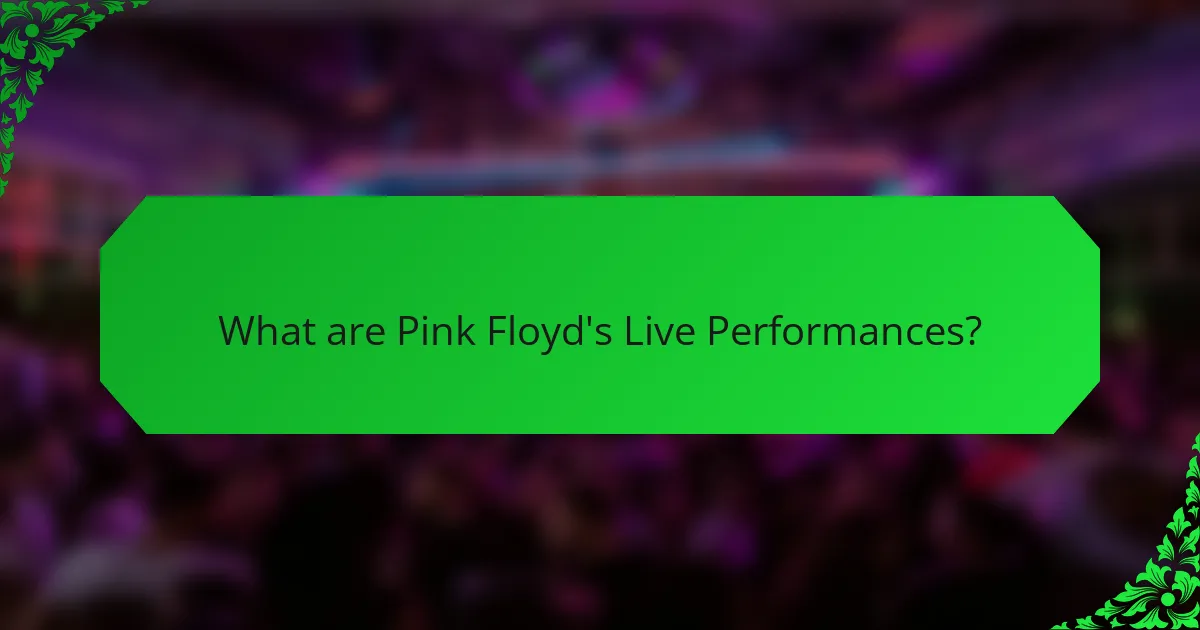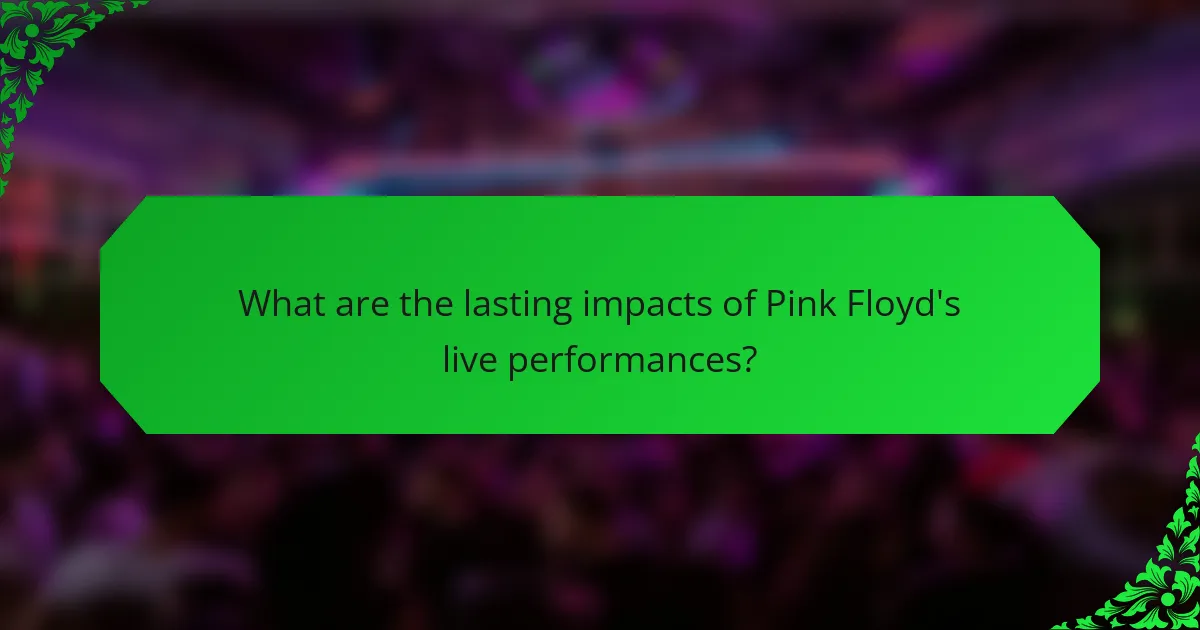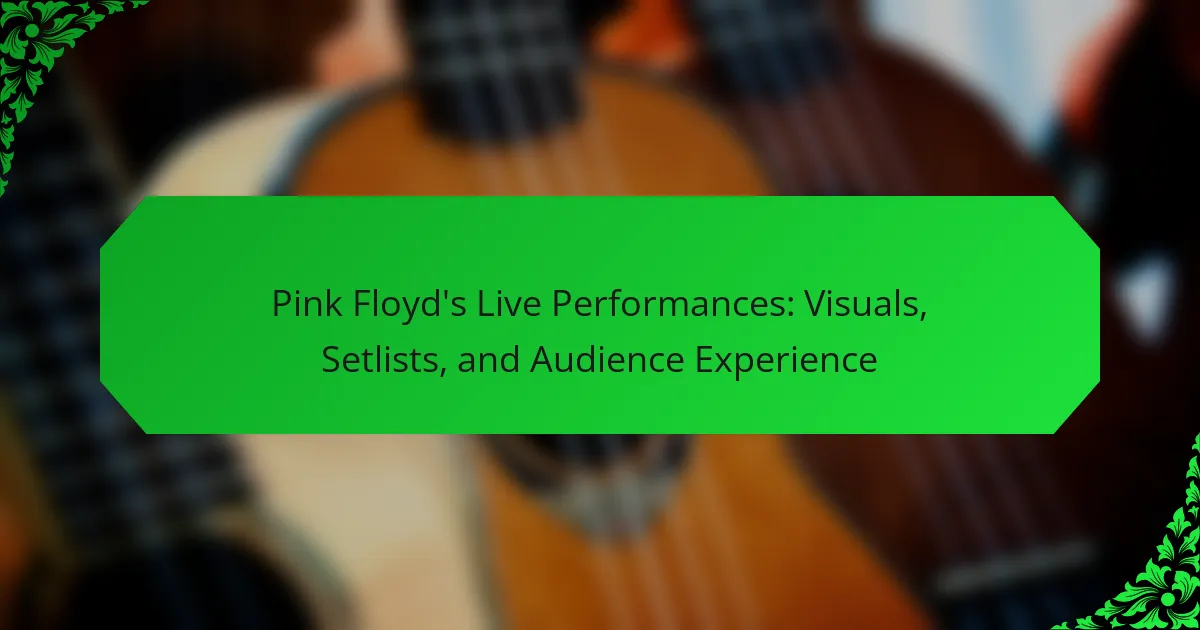Pink Floyd’s live performances are characterized by their innovative integration of elaborate visuals, unique soundscapes, and immersive audience experiences. The band utilized advanced lighting, projections, and thematic stage designs, creating a transformative concert atmosphere that emphasized albums such as “The Dark Side of the Moon” and “The Wall.” Audience engagement played a critical role in shaping setlists and performance dynamics, with emotional responses influencing the band’s improvisational elements. Pink Floyd’s pioneering approach to live music set new standards in the industry, leaving a significant legacy that continues to impact contemporary artists and performances.

What are Pink Floyd’s Live Performances?
Pink Floyd’s live performances are renowned for their elaborate visuals and unique soundscapes. The band integrated innovative lighting, projections, and stage designs into their shows. They often featured large-scale visual effects, including animations and thematic imagery. Their concerts typically included a mix of songs from their extensive catalog, emphasizing albums like “The Dark Side of the Moon” and “The Wall.” Audience experiences were enhanced by immersive audio and visual elements. Pink Floyd’s performances set a standard for live rock concerts. Their use of technology influenced future generations of musicians and performers. The band played iconic venues and festivals, leaving a lasting legacy in live music history.
How did Pink Floyd’s live performances evolve over time?
Pink Floyd’s live performances evolved significantly from the mid-1960s to the 1990s. Initially, their shows featured simple light displays and basic sound systems. As they gained popularity, they incorporated elaborate visual effects and innovative stage designs. The release of “The Dark Side of the Moon” in 1973 marked a turning point. Their performances became more theatrical, integrating slides and films. By the late 1970s, their shows included large-scale props and complex light shows. The 1980s saw the introduction of cutting-edge technology, such as laser displays. Their final tours in the 1990s showcased a blend of music and visual artistry on an unprecedented scale.
What were the key milestones in their live performance history?
Pink Floyd’s live performance history includes several key milestones. In 1967, they gained attention with their performance at the UFO Club in London. Their 1970 concert at the Isle of Wight Festival marked one of their largest audiences at the time. The 1972 release of “The Dark Side of the Moon” was accompanied by innovative visual effects in live shows. The 1975 “Wish You Were Here” tour featured elaborate stage setups and lighting. In 1980, they introduced the “The Wall” tour, which was notable for its theatrical elements. The 1994 “The Division Bell” tour showcased advanced technology and holograms. Lastly, their 2005 reunion performance at Live 8 was a significant moment, bringing the band back together for a global audience. Each of these milestones reflects the evolution of Pink Floyd’s live performances and their impact on music history.
How did technological advancements influence their performances?
Technological advancements significantly influenced Pink Floyd’s live performances. Innovations in sound engineering allowed for higher fidelity audio. This resulted in a richer listening experience for the audience. Visual technology, such as projectors and lasers, enhanced the overall spectacle. The use of elaborate stage designs created immersive environments. Additionally, advancements in lighting technology synchronized with music increased emotional impact. These elements combined to create a unique and memorable concert experience. Pink Floyd’s integration of technology set new standards for live performances in the music industry.
What role do visuals play in Pink Floyd’s live performances?
Visuals play a crucial role in Pink Floyd’s live performances. They enhance the emotional impact of the music. The band is known for elaborate light shows and projections. These visuals create a multi-sensory experience for the audience. Iconic elements include the use of large screens and animations. The visuals often reflect the themes of the songs. For example, “The Wall” features powerful imagery related to isolation and criticism. This integration of visuals with music distinguishes Pink Floyd from other bands. The combination of sound and visuals has become a defining characteristic of their concerts.
How are visuals integrated into their stage design?
Visuals are integrated into Pink Floyd’s stage design through elaborate light shows, video projections, and innovative set designs. These elements create an immersive experience that enhances the music. For example, during performances of “The Wall,” large-scale projections of animations and imagery accompany the live music. This integration of visuals helps convey the themes of the songs. The use of synchronized lights and lasers adds to the dramatic effect. Additionally, the band’s commitment to visual artistry is evident in their iconic album covers, which often influence stage aesthetics. Overall, the combination of these visual elements significantly elevates the audience’s experience during live performances.
What are some iconic visual elements used in their shows?
Iconic visual elements used in Pink Floyd’s shows include elaborate light shows, large-scale projections, and intricate stage designs. Their performances often featured synchronized laser displays. Iconic imagery such as the flying pig and the giant inflatable teacher are also prominent. The use of visual storytelling enhances the thematic depth of their music. Additionally, the band incorporated multimedia elements, like films and animations, to create immersive experiences. These visuals helped convey the band’s messages and emotions effectively. The combination of music and visuals set Pink Floyd apart in live performance history.
What can we learn from Pink Floyd’s setlists?
Pink Floyd’s setlists reveal their musical evolution and thematic focus. The songs chosen reflect the band’s artistic journey over the years. For example, early setlists feature tracks from “The Piper at the Gates of Dawn.” Later performances emphasize albums like “The Dark Side of the Moon” and “The Wall.”
The inclusion of specific songs highlights their experimentation with sound and technology. Setlists often showcase the band’s iconic use of visual effects and stage design. The variation in song selection across tours indicates their response to audience reception.
Analysis of setlists can also show how the band tailored performances to different venues. Overall, Pink Floyd’s setlists serve as a historical record of their creative development and audience engagement.
How do setlists reflect the band’s musical evolution?
Setlists reflect a band’s musical evolution by showcasing the progression of their song selection over time. As bands develop, they often incorporate new material that reflects their changing sound and artistic direction. For example, Pink Floyd’s early setlists primarily featured songs from their debut album and early singles. As they evolved, their setlists began to include tracks from concept albums like “The Dark Side of the Moon” and “Wish You Were Here.” This shift demonstrates their transition from psychedelic rock to more complex themes and compositions.
Setlists also highlight the band’s experimentation with different musical styles. Over the years, Pink Floyd integrated elements of progressive rock, electronic music, and orchestration into their performances. The inclusion of songs like “Comfortably Numb” and “Run Like Hell” in later setlists emphasizes this diversification in sound.
Additionally, setlists often reflect the band’s response to audience reception and cultural context. For instance, during the late 1970s, Pink Floyd’s setlists featured more politically charged songs, aligning with the social climate of the time. This adaptability shows their awareness of the audience’s expectations and the evolving music landscape.
Overall, analyzing setlists provides insight into how Pink Floyd’s musical journey is mapped through their live performances. Each setlist serves as a historical record of their artistic growth and the changing dynamics of their music.
What are the most frequently played songs in their live shows?
Pink Floyd frequently played “Comfortably Numb,” “Wish You Were Here,” and “Another Brick in the Wall, Part 2” during their live shows. These songs are iconic and resonate with audiences. “Comfortably Numb” is known for its powerful guitar solos and emotional lyrics. “Wish You Were Here” reflects themes of absence and nostalgia. “Another Brick in the Wall, Part 2” critiques the education system. Their setlists often featured these tracks throughout various tours. Concert recordings and fan recollections confirm their popularity in live performances.

How does the audience experience shape Pink Floyd’s live performances?
The audience experience significantly shapes Pink Floyd’s live performances. Their shows are known for immersive visuals and elaborate stage designs. This engagement transforms the concert into a shared emotional journey. The band’s use of synchronized light shows enhances audience connection. This interaction influences the setlist choices, often tailored to audience reactions. Live recordings reveal the impact of crowd energy on performance dynamics. Historical performances, like the 1977 “Animals” tour, demonstrate this relationship. The audience’s emotional responses inform the band’s improvisational elements during shows. Overall, the audience experience is integral to the essence of Pink Floyd’s live performances.
What emotions do Pink Floyd’s performances evoke in audiences?
Pink Floyd’s performances evoke a range of deep emotions in audiences, including nostalgia, introspection, and awe. Their music often reflects themes of alienation and existentialism, resonating with listeners on a personal level. The elaborate visuals and immersive soundscapes enhance emotional experiences during live shows. Audience members frequently report feelings of euphoria and catharsis, especially during iconic tracks like “Comfortably Numb” and “Wish You Were Here.” The combination of poignant lyrics and innovative stage design creates a unique atmosphere. This emotional impact is supported by numerous fan testimonials and critical reviews highlighting the profound connection felt during their concerts.
How do audience reactions influence the band’s performance style?
Audience reactions significantly influence a band’s performance style. Bands often adjust their energy levels based on audience engagement. Positive reactions, such as cheers and applause, can lead to more dynamic performances. Conversely, a subdued audience may cause a band to adopt a more relaxed style.
This responsiveness reflects the band’s desire to connect with their audience. For instance, Pink Floyd often enhanced their visual and musical elements in response to audience reactions. They utilized elaborate light shows and stage designs to amplify the experience when the crowd was highly engaged.
Research indicates that live performance dynamics shift according to audience feedback. A study by the University of Southern California found that musicians adapt their playing style in real-time based on audience reactions. This adaptability is crucial for creating memorable live experiences.
What are some memorable audience interactions during their shows?
Memorable audience interactions during Pink Floyd’s shows include the iconic “The Wall” performances. During these concerts, audience members often participated by singing along to “Another Brick in the Wall.” This song featured a children’s choir, which enhanced the communal experience. Additionally, during the “Pulse” tour, the band encouraged fans to wave light sticks, creating a sea of lights. Fans also frequently expressed their emotions by cheering loudly during solos, especially during “Comfortably Numb.” The elaborate visuals often captivated the audience, resulting in collective gasps and applause. Interactions like these turned concerts into immersive experiences, fostering a deep connection between the band and their fans.
How do different venues affect the live experience?
Different venues significantly affect the live experience of performances. The size and layout of a venue influence audience engagement. Smaller venues often create an intimate atmosphere, allowing for closer interaction with the performers. Larger venues can enhance sound and visual effects but may reduce personal connection. The acoustics of each venue also play a critical role in sound quality. Venues with superior acoustics enhance musical clarity and audience enjoyment. Additionally, the venue’s location can impact accessibility and audience demographics. For example, urban venues may attract diverse crowds, while rural venues may cater to local fans. Ultimately, each venue shapes the overall experience through its unique characteristics and environment.
What are the unique challenges of performing in large stadiums vs. smaller venues?
Performing in large stadiums presents unique challenges compared to smaller venues. In large stadiums, sound distribution is a significant issue. The distance between the stage and the audience can create delays in audio, affecting the overall experience. Visuals also become more complex; elaborate light shows may not be as effective in vast spaces. In smaller venues, performers can connect more intimately with the audience. The atmosphere is usually more personal, allowing for better engagement. Additionally, logistics differ; larger venues require extensive setup and coordination. Crowd management becomes crucial in stadiums due to the larger audience size. Overall, each setting demands different performance strategies and adaptations.
How does venue acoustics impact the overall performance?
Venue acoustics significantly impact overall performance quality. Acoustics determine how sound travels and interacts within a space. Poor acoustics can lead to muddied sound, making it hard for the audience to hear nuances. Conversely, good acoustics enhance clarity and richness of the music. This is crucial for a band like Pink Floyd, known for intricate soundscapes. A well-designed venue allows for balanced sound distribution. It can amplify the emotional experience of the performance. Studies show that acoustically favorable venues improve audience satisfaction. Thus, venue acoustics play a vital role in live music experiences.

What are the lasting impacts of Pink Floyd’s live performances?
Pink Floyd’s live performances have had significant lasting impacts on music and culture. Their innovative use of visual effects transformed the concert experience. The incorporation of elaborate light shows and projections set new standards for live music. This approach influenced countless artists and bands in the decades that followed. Their performances often conveyed deep themes, making concerts a form of artistic expression. The emotional connection established with audiences created a loyal fan base. Albums like “The Wall” were brought to life through theatrical stage designs. This integration of narrative and music has inspired modern rock operas and performances. Overall, Pink Floyd’s live shows reshaped expectations for live entertainment.
How have Pink Floyd’s live performances influenced other artists?
Pink Floyd’s live performances have significantly influenced other artists by setting new standards for concert experiences. Their integration of elaborate visual effects, including light shows and projections, transformed live music into a multi-sensory event. This approach has inspired artists across various genres to enhance their own performances with similar visual elements. Bands like U2 and Radiohead have cited Pink Floyd’s innovative stage designs as a key influence on their own concerts. The use of narrative and thematic continuity in performances has also encouraged artists to create cohesive experiences rather than just a series of songs. Furthermore, Pink Floyd’s emphasis on sound quality and technological advancements in live audio has pushed other musicians to prioritize high production values. Their iconic shows have become a benchmark, leading to larger and more ambitious live productions in the music industry.
What elements of their performances have been adopted by contemporary musicians?
Contemporary musicians have adopted elements such as elaborate visual effects, immersive light shows, and thematic storytelling from Pink Floyd’s performances. These elements enhance the overall audience experience. The use of synchronized multimedia presentations has become a standard in live shows. Additionally, the integration of conceptual themes into setlists is prevalent. Many artists now focus on creating a cohesive narrative throughout their performances. Pink Floyd’s approach to soundscapes and atmospheric music has also influenced modern genres. Their pioneering use of technology in live settings set a precedent for future acts. This blend of audio-visual artistry has shaped how concerts are produced today.
What practical tips can enhance the experience of attending a Pink Floyd tribute show?
Arrive early to secure good seating and soak in the atmosphere. Familiarize yourself with the setlist in advance to enhance engagement. Dress comfortably, as tribute shows can last several hours. Bring ear protection to safeguard your hearing during loud performances. Capture memories with photos, but be respectful of the performers and audience. Engage with fellow fans to share excitement and insights. Stay hydrated and consider snacks for energy. Participate in any interactive elements to fully immerse yourself in the experience.
How can fans prepare for an immersive live performance experience?
Fans can prepare for an immersive live performance experience by researching the event and understanding the setlist. Knowing the songs enhances engagement during the performance. Fans should also familiarize themselves with the visuals and themes used in the show. This knowledge can heighten emotional responses and connection to the music.
Arriving early is important for securing a good spot and absorbing the atmosphere. Fans should also consider the venue’s layout and accessibility. Dressing comfortably is essential for enjoying the performance without distractions. Hydration and light snacks can help maintain energy levels throughout the event.
Bringing ear protection may be beneficial due to the high volume of live music. Engaging with fellow fans can enhance the communal experience. Overall, preparation enhances enjoyment and connection during the immersive performance.
Pink Floyd’s live performances are characterized by their elaborate visuals, innovative soundscapes, and immersive audience experiences. The article explores the evolution of these performances from the 1960s to the 1990s, highlighting key milestones and the influence of technological advancements on their shows. It also examines the role of visuals in enhancing emotional connections, the impact of setlists on musical evolution, and the significance of audience interactions. Additionally, the lasting effects of Pink Floyd’s performances on contemporary musicians and the concert experience are discussed, providing insights into how fans can prepare for tribute shows.
